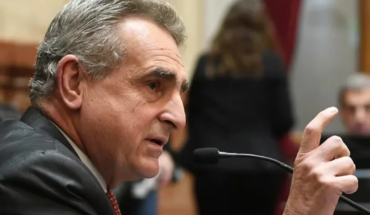The battleship USS Arlington, equipped with amphibious vehicles And aerial aboard, will join the carrier USS Abraham Lincoln as an attack group in the Gulf.
In addition, B-52 bombers have reached an American base in Qatar, according to the Pentagon.
Without being specific, the U.S. reported that displacement is in response to a possible threat from Iran against US forces in the region.
The government in Tehran catalogued the allegations of nonsense.
And branded the recent displacement of “psychological warfare” in order to intimidate the country.
This week, Iran had also suggested that it could resume its uranium-enrichment nuclear activity.
Why is America sending additional forces?
The Pentagon claims that its forces are responding to a possible threat, but did not specify what it would be.
The latest Pentagon communiqué this Friday only noted that Washington was “prepared to defend American forces and interests in the region,” adding that the U.S. was not seeking a conflict with Iran.
Currently, there are some 5,200 troops stationed in the neighboring country, Iraq.
The U.S. Patriot missile system (Photo archive)
The Patriot system is capable of intercepting ballistic missiles, cruise missiles and advanced-technology aircraft.
Officials commented to the U.S. media that the USS Arlington was already scheduled to navigate to the region, but that its displacement went ahead to add command and control support.
The carrier USS Abraham Lincoln traversed the Suez canal this Thursday, reported in U.S. Central command.
According to the semi-state news agency IRNA, the high Iranian cleric, Yousef Tabatabai-Nejad, said the US military fleet could be “destroyed with a missile.”
What is the status of the U.S. relationship? USA-Iran?
Last year, US President Donald Trump withdrew unilaterally from the historic nuclear agreement that the U.S. and other nations signed with Iran in 2015.
As negotiated, Iran had agreed to limit its troubling nuclear activities and allow international inspectors to enter in exchange for a relaxation of the sanctions imposed on them.
The surprise visit of the Secretary of State, Mike Pompeo (der), to Iraq this month increased the tensions.
Last month, Washington also blacklisted Iran’s Revolutionary Guard elite, designating it as an international terrorist group.
The White House proceeded to curb concessions that allowed five countries–China, India, Japan, South Korea, and Turkey–to buy oil from Iran.
Sanctions have led to a sharp fall in the Iranian economy, plunging the value of its currency to record levels, frightening international investors and generating protests.
Trump’s government hopes to force Iran to negotiate a “new deal” that would not only cover its nuclear activities, but also its ballistic missile program and what officials in Washington call its “malignant behavior” across the Middle East.
For their part, Iran has repeatedly threatened to retaliate against U.S. measures by blocking the Strait of Hormuz, through which a fifth of world oil passes.
The value of the Iranian currency, the rial, has plummeted against the US dollar.
Earlier this week, Iran announced that it had suspended two of its obligations related to the 2015 agreement, in response to the restoration of U.S. sanctions.
It also threatened to accelerate uranium enrichment if it was not protected from American sanctions within the next 60 days.
The European powers stated that they were committed to Iran’s nuclear agreement but that they “reject any ultimatum” issued by Iran.
Analysis by Jonathan Marcus, BBC defense correspondent
The real battle that will define the fate of Iran’s nuclear agreement has begun.
In the year since Trump’s government withdrew unilaterally from the pact, Iran and the other parties involved have continued to respecting, despite everything. And the International Atomic Energy Agency, the global agency that monitors nuclear activity, has repeatedly given Tehran its approval. Iran has fulfilled its commitments.
But Iranian compliance is not the issue for Trump’s government, which simply says that this is a bad deal. The main European allies of the United States, with Russia and China, do not coincide. So Washington is intensifying pressure on Tehran.
The effect on Iran’s economy has been severe, and the Iranian government has just decided to take action, announcing that it will not continue to respect the restrictions on the storage of enriched uranium and heavy water, in addition to imposing a deadline on the parties involved in the Convention to implement their commitments.
A couple of difficult months of diplomacy are looming, with no guarantee of success. Trump’s government is sure to see its ultimate goal: the collapse of the nuclear agreement. But the danger of a conflict, whether by accident rather than by intent, is on the rise.
translated from Spanish: USA vs Iran: Why is Washington sending Bombers B-52 and a battleship with anti-missile system to the Middle East?
May 11, 2019 |





